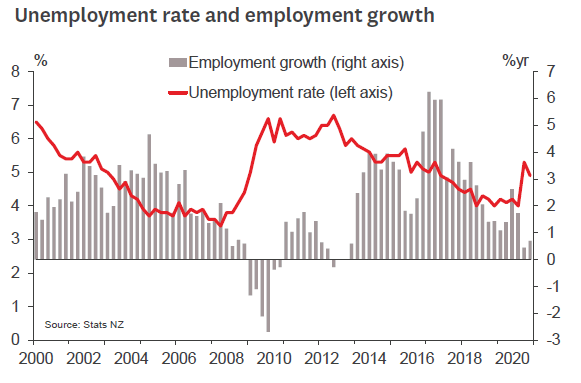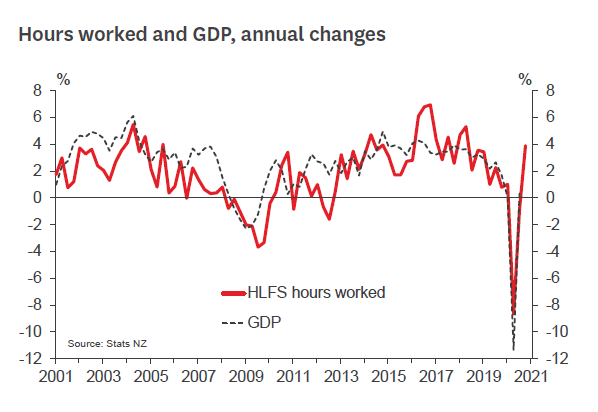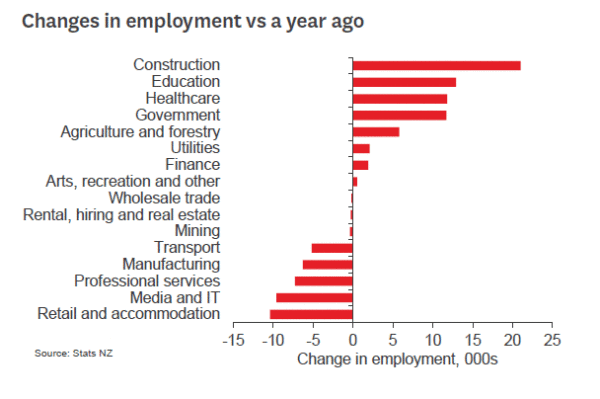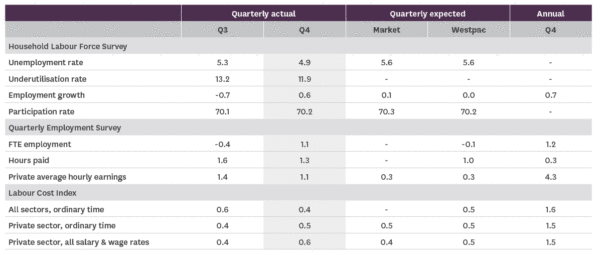- The unemployment rate fell to 4.9% in the December quarter, a much stronger result than expected.
- Growth in construction and government related areas has outweighed the losses in those sectors affected by the border closure.
- With improving signals from the likes of tax data and job advertisements, we think that the unemployment rate is at or near its peak.
- We are not changing our monetary policy call at this point, but it’s starting to look like the RBNZ could tighten sooner than we previously anticipated.
New Zealand’s labour market has again proven to be more resilient than expected. The unemployment rate fell from 5.3% to 4.9% in the December quarter, far outstripping forecasts (including ours and the Reserve Bank’s) of an increase to 5.6%.
Even before today’s figures, our view was that unemployment was nearing its peak. Indicators based on tax data suggest that the number of jobs has picked up after last year’s Covid-19 lockdown, and job ads show that firms are rapidly returning to hiring. Now, it looks like that peak in unemployment will be even lower than we thought. The economy is heading into its post-Covid recovery with much less slack than anyone expected.
These results are of course welcome, but they represent a shot across the bow for policymakers. The rebound in the level of GDP, the surging housing market, higher than expected inflation, and now falling unemployment all make it obvious that the combined efforts of the Government and Reserve Bank to support the economy through the Covid shock have had a much more powerful effect than anticipated.
That calls into question just how much ongoing stimulus is appropriate, particularly over the period when vaccines are rolled out and global travel resumes. It’s becoming increasingly possible that the RBNZ will regret some of the stimulus measures that it put in place last year, and could start to tighten policy sooner than we previously anticipated
Details.
The drop in the unemployment rate reflects a solid rise in the number of people employed, along with a small lift in labour force participation. While quarterly jobs growth can be volatile – hence why we typically recommend focusing on the unemployment rate – the fact that it was consistent across both the Household Labour Force Survey (HLFS) and the employer-based Quarterly Employment Survey (QES) reinforces the result.
Not only is the number of jobs rising, there’s also a sense of returning normalcy within the workforce. There was a sharp drop in the number of underemployed workers, a shift away from part-time towards full-time work, and a drop in the number of people working reduced hours to around pre-Covid levels. The number of hours worked were, astonishingly, up nearly 4% on a year ago.
That by no means implies a full recovery from the Covid shock. The closure of the border in particular has seen a substantial drop in employment over the last year in areas such as retail and accommodation, transport, media and travel services. But that’s been outweighed by growth in other sectors. In particular, construction is on a tear, with the number of workers up 8% on a year ago. There has also been substantial growth in Government-funded areas like healthcare, education, and public services.
As good as today’s results were, the fact remains that the labour market is less tight now than it was a year ago. By 2019 the unemployment rate had fallen to around 4%, and a long-awaited pickup in wage inflation was finally becoming apparent. (Our estimate of an inflation-neutral unemployment rate is around 4.5%.) That progress was unwound in 2020, and we’ve seen a drop in the pace of wage growth as well.
The Labour Cost Index (LCI) slowed to 1.6% annual growth in December, compared to 2.6% a year earlier. The slowdown reflects the sense that while jobs and hours may be returning to normal, pay increases remain hard to come by in the post- Covid environment. Only 45% of jobs have seen a pay increase at all in the last year, the lowest proportion since March 2010. Given the usual lag from unemployment to wage growth, there’s likely to be some further softness in the near term. 
















